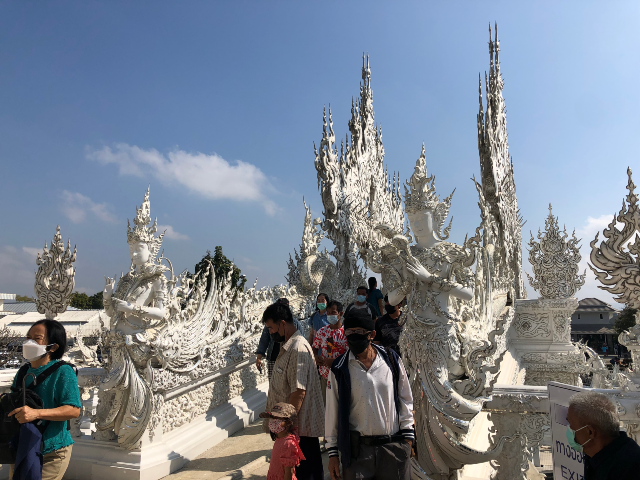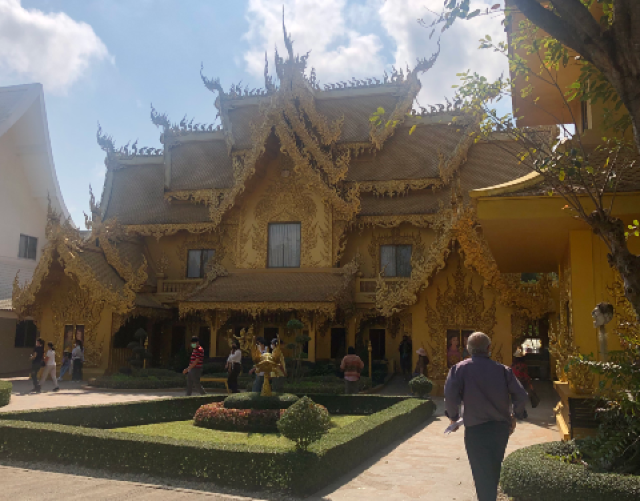Any tourist visiting Chiang Rai does not miss going to see this temple. Even we belonged to that category. We reached Chiang Rai at around 10:30 am, a short flight from Bangkok. Checked into the hotel, packed our bag for the day and off to Wat Rung Khun. It was the first wat we visited. We had at least 4 places planned for the day so didn't want to waste any time.
Around 45 minutes drive, we were in front of the temple. It was not as big as I had visualized it to be. More buildings are being constructed, read there were going to be nine buildings, so maybe by the time it is completed, it would be a massive temple.About the temple:
The architecture of this temple is the brainwork of Buddhist Thai painter, Chalermchai Kositpitat. The earlier existing wat in its place was in dire need of repair. Chalemchai, a native of Chiang Rai came forward to give it an entirely new look and interpretation of his work. The work on building started in 1997 and according to the artist, it shall take many more years to complete.
The building is made in white with pieces of mirror on it which makes the place glow in sun. According to the artist, white stands for purity and the mirrors represent righteousness or dhamma.
The art work is different and nothing like the wats we are used to seeing. Being traditional in my thinking, the interior of ubosot took me some time to understand the architect's point of view.
As one goes through the temple, one wonders the symbolism in architecture.
White color and use of mirrors: White signifies purity and mirror has been used as a symbol of Buddha teachings which shine in the sun, thus spreading its light everywhere.
Bridge crossing over outstretched hands: One gets over the cycle of rebirth by crossing this bridge which leads you to Heaven.
Giant tusks on either side: these represent the mouth of desire and we need to avoid not to fall into that trap.
Apart from these, there are many things the architect has added to his imagination, I shall try to cover them and see from his point of view.
The temple deviates from a normal wat in its decor and representation.hanging heads welcome the visitors, something different
does the alchohol bottle mean that we abstain from drinking?another tree
bell on side of temple
The bridge of the cycle of rebirth:
Hindu and Buddhist philosophy strongly believe in rebirth. A person is caught in this web of rebirth by succumbing to all the worldly desires. Let me try to explain the significance of what I have understood.
Two giant tusks represent the mouth of demon which lures you in this wordly pleasures, that is why they are not the bridge but below on its side.Below the bridge, are hands coming out representing worldly desires like lust and greed. We get caught in whirlpool of these worldly pleasures and are unable to reach enlightenment. The white semi-circle represents the earth in which we live.
You have to be strong enough not to succumb to any temptation and desires.
On looking carefully, you just see one finger with red paint on the finger. This symbolizes that knowing physical beauty is superficial, we go for it.entering the "Gate to Heaven"
once you cross the small bridge, there is no turning back. The entrance to the bridge over the ocean is guarded by two dvarpala or yaksha or temple guardians on either side.
The monsters or demons signify the causes of sorrow.
tail of naga
albino koi fish to go along with the temple theme
The fish are said to be imported from Japan.
There is a pond below the bridge which represents the great sea or the "Sithandon Ocean". This is ocean from where the milk of elixer came out.
ubosot, hatstadiling on bargeboards
Since no one is permitted to come back, you take off your footwear, take them along inside the ubosot and either place them in shoe rack in the corner or carry them with you. Philosophically, once you enter heaven there is no coming back.
Hatstadiling, a mythological animal which has head and trunk of an elephant, comb of a cock, body of a lion and wings like a bird. It is said to inhabit the forests of Himavanta, in Himalayas.Hatsdaling is also referred by other names: nok hatsading, nok hatsadi, nok hat in Thai.
The highest point represents Mount Meru, which mythologically is the center of universe.kinnars, half bird and half human at the end of bridge
As you climb up the ramp, there are four lotus marked, which represent the "Four stages of Enlightenment". They are said to be Sotapanna, Sakdagami, Anagami, and Arahant.Buddha image in meditative posture above the entrance to ubosot
three-tiered ubosot
Boddhisattva at entrance to ubosot
After this point, no photography would be permitted, I shall wirte what I see inside. There are many sites which have posted few pictures.Inside the ubosot:
Straight ahead on entrance, you see multi-tiered image of Buddha.
A white image of Buddha sits in Vitarka mudra, in which thumb and first finger touch each other. The three fingers point towards heaven with palms facing outwards.
This mudra symbolizes knowledge gained after reaching enlightenment. The image sits on a gold lotus.
Just below the above image, is another golden image in bhumisparsh mudra. On the wall behind the both images, is floor to ceiling painting of Buddha in gold.
The interior including the floor is orange-gold.
In place of usual paintings of Buddha or his life, are paintings of modern characters from Superman, Star Wars images, burning of twin toweres with faces of George W. Bush and Osama Bin Laden, also paintings of sorrow and pain in the world.
As one exits and turns to have a last look, you see an open mouth of a monster around the door you just entered into the ubosot, symbolizing that you have just entered out of monster's mouth into heaven.
structure on exiting ubosot, were not allowed to go in
naga at one side gate
Makar mouth guarding the temple
another hatsdaling in lawns
image on a gate
Looks like Khochasi, a mythological animal. Lion with elephant's trunk and ears.There is a corridor from which hang silver leaves from the roof.Also, there is a concrete tree trunk from which hang silver leaves. Anyone wanting to make a wish, buys the leaf for 30 Baht and hangs it on the tree or on the roof of corridor hoping for the wish to be fulfilled.
Chinese zodiac signs
Ahha, one is surprised to see a golden building between white. These are the rest rooms.
Gold color represents body and earthly desires.
inside of restroom
There is a golden tree in which are two images of Buddha.
turtle with wings
naga serpent at side entrance to ubosot
Timings: 8:00 A.M. - 5 P.M.
entrance: free for Thai nationals, 100 Thai Baht for foreigners















































No comments:
Post a Comment
Thanks for visiting my blog. Your feedback is always appreciated.